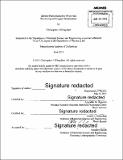| dc.contributor.advisor | Anuradha M. Agarwal. | en_US |
| dc.contributor.author | Klingshim, Christopher J | en_US |
| dc.contributor.other | Massachusetts Institute of Technology. Department of Physics. | en_US |
| dc.date.accessioned | 2015-09-17T18:59:45Z | |
| dc.date.available | 2015-09-17T18:59:45Z | |
| dc.date.copyright | 2015 | en_US |
| dc.date.issued | 2015 | en_US |
| dc.identifier.uri | http://hdl.handle.net/1721.1/98614 | |
| dc.description | Thesis: S.B. in Materials Science and Engineering, Massachusetts Institute of Technology, Department of Physics, 2015. | en_US |
| dc.description | Cataloged from PDF version of thesis. | en_US |
| dc.description | Includes bibliographical references (pages 33-34). | en_US |
| dc.description.abstract | Infrared (IR) thermal detectors and photodetectors have significant applications including thermal imaging, infrared spectroscopy and chemical and biological sensing. In this work we focus on photodetectors, which typically use narrow gap semiconductor materials requiring cryogenic cooling to provide measurable signals above thermally generated noise. Our study investigates one class of photodetectors, namely photoconductive semiconductor films. When embedded within resonant cavities, these films are additionally capable of precise detection at narrow, selectable bands and enable the development of monolithically-integrated detectors that are physically small, highly responsive and able to record data autonomously. Lead chalcogenides such as PbTe are ideal photoconductive material candidates because (i) low-cost thermal deposition produces polycrystalline films that exhibit good mid-IR responsivity without being subject to lattice-matching constraints, and (ii) they do not require cryogenic cooling. We show that the responsivity of polycrystalline PbTe is enhanced by oxidation annealing. This investigation sought to determine a viable set of processing conditions for thermally depositing oxygen-sensitized PbTe photoconductors on Si substrates. Depositions were performed under high vacuum on the order of 1 0-6 Torr. Physical shadow-mask and photolithographic techniques were used to pattern the films in order to produce photoconductive samples with varied film and electrical contact geometries. The introduction of non-functional "dummy layers" within 100-300 pm of the usable samples prevented undesired film peeling during the lift-off process. PbTe films displayed an FCC rocksalt structure and slight preference for (200) texture when thermally deposited on a Si substrate. A 250-nm thick sample exhibited large photoconductivity, with responsivity higher than 100 V/W between 2-3 [mu]m wavelengths, a factor of 4 higher than literature values for similar films. Sn metal formed highly ohmic contacts with the PbTe layer, permitting Hall experiments that showed the film to be p-type with a carrier concentration of 1.49 x 1017 cm-3 and Hall mobility of 21 cm 2 V-1 s-. The carrier concentration was thermally activated with activation energy of 0.137 eV. These values are comparable to past experiments in which the film was sensitized by exposure to oxygen at ambient conditions. Further research is needed to establish the exact origin of the enhanced photoconductivity observed. | en_US |
| dc.description.statementofresponsibility | by Christopher J. Klingshim. | en_US |
| dc.format.extent | 34 pages | en_US |
| dc.language.iso | eng | en_US |
| dc.publisher | Massachusetts Institute of Technology | en_US |
| dc.rights | M.I.T. theses are protected by copyright. They may be viewed from this source for any purpose, but reproduction or distribution in any format is prohibited without written permission. See provided URL for inquiries about permission. | en_US |
| dc.rights.uri | http://dspace.mit.edu/handle/1721.1/7582 | en_US |
| dc.subject | Physics. | en_US |
| dc.title | Infrared photoconductive PbTe film processing and oxygen sensitization | en_US |
| dc.type | Thesis | en_US |
| dc.description.degree | S.B. in Materials Science and Engineering | en_US |
| dc.contributor.department | Massachusetts Institute of Technology. Department of Physics | |
| dc.identifier.oclc | 920473845 | en_US |
